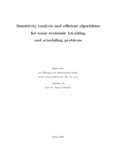Citation link:
https://nbn-resolving.org/urn:nbn:de:hbz:467-2399Files in This Item:
| File | Description | Size | Format | |
|---|---|---|---|---|
| chubanov.pdf | 876.19 kB | Adobe PDF |  View/Open |
| Dokument Type: | Doctoral Thesis | metadata.dc.title: | Sensitivity analysis and efficient algorithms for some economic lot-sizing and scheduling problems | Authors: | Chubanov, Sergei | Institute: | Fachbereich 5, Wirtschaftswissenschaften, Wirtschaftsinformatik und Wirtschaftsrecht | Free keywords: | Losgrößenmodell, Reihenfolgeproblem, Algorithmus | Dewey Decimal Classification: | 650 Management | GHBS-Clases: | QBB | Issue Date: | 2006 | Publish Date: | 2006 | Abstract: | Many of optimization problems can be decomposed into a number of easier subproblems of the same type. Then dynamic programming (DP) seems to be a natural way to obtain an optimal solution. A straightforward application of DP usually leads to algorithms whose running time heavily depends on the magnitude of the input data. It has been shown in the thesis that it is possible to improve the complexity status of straightforward DP algorithms for different optimization problems, arising in production planning and scheduling, by means of a sensitivity analysis that allows to shrink the state space and to reduce thereby the amount of unnecessary computations. Using the suggested approach, we transform DP algorithms into polynomial ones and into so-called fully polynomial time approximation schemes. Viele Optimierungsprobleme können als Menge einfacherer Subprobleme dargestellt werden. Dynamische Programmierung (DP) ist dann ein offensichtliches Verfahren eine optimale Lösung zu finden. Eine direkte Anwendung der DP führt aber in den meisten Fällen zu Algorithmen, deren Laufzeiten sehr von der Größe des Inputs abhängen. In der vorliegenden Dissertation wirt an bestimmten Produktionsplanungs- und Schedulingproblemen gezeigt, dass man die Laufzeit der auf DP basierenden Algorithmen verbessern kann, falls eine Art von Sensitivitätsanalyse nachträglich verwendet wird. Mit den vorgestellten Methoden werden solche Algorithmen in polynomiale Algorithmen und in so genannten vollpolynomiale Approximationsschematas transformiert. |
URN: | urn:nbn:de:hbz:467-2399 | URI: | https://dspace.ub.uni-siegen.de/handle/ubsi/239 | License: | https://dspace.ub.uni-siegen.de/static/license.txt |
| Appears in Collections: | Hochschulschriften |
This item is protected by original copyright |
Page view(s)
428
checked on Jan 14, 2025
Download(s)
128
checked on Jan 14, 2025
Google ScholarTM
Check
Items in DSpace are protected by copyright, with all rights reserved, unless otherwise indicated.

